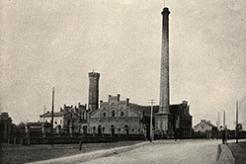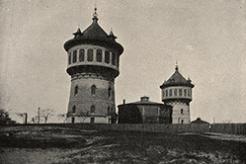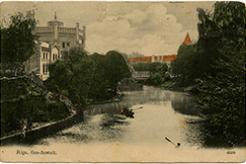




Author: Agrita Tipāne, Dr. arch.
The progress of technologies in the end of the 19th century and the beginning of the 20th century changed people’s lives. Already in the middle of the 19th century, due to the development of science and technologies, people began to use new types of lighting, build new water and sewer systems, modernize heating, and introduce new means of transportation. The changes were widespread – trams and automobiles began to run in cities, the issues of lighting of streets and premises were resolved, cities received water of good quality, and the issues of sewerage were put in order, modern heating systems were installed in many houses. People’s attitudes towards own body also changed, leading to better care for health and personal hygiene.
An important period in the history of Riga was the time when the mayor of the city was George Armitstead, who supported a number of innovations and introduced them to life (Fig. 1). A significant impulse to the technological progress was also the exhibition held in 1901 where many companies advertised the latest technological achievements (Fig. 2).
The most significant changes occurred in urban and residential lighting. For centuries, premises had been illuminated with candles that were produced from stearin, palm oil and fat, and that gave little illumination. Beginning from the first half of the 19th century, premises were illuminate with oil lamps (light intensity equivalent to 3 candles), but in the middle of the 19th century, gas lamps took over, providing light intensity already equivalent to 12-15 candles. However, gas lamps were mostly used to illuminate the city – they were considered dangerous for household use and were therefore rarely used indoors. The Board of Riga had been considering modernization of the lighting of the city already since the 1830s, but the permission from the General Governor of Vidzeme to install gas lighting was received only in 1858. In 1862, in the place of the former Jekabs’ ravelin next to the canal, the first gas factory of Riga was built. A 28.5 km long cast iron pipeline system was constructed, and the streets were illuminated by gas lanterns (Fig. 3). 678 gas lanterns were installed in the city, however, the single factory was not able to provide a sufficient supply of gas to the entire city, and therefore another factory was built in 1874 – 1875 between Matisa and Brininieku streets (Fig. 4 and 5). In 1882, the factory was modernized, expanded and rebuilt, and it became the main gas producer in the city. The old gas factory by the canal was closed in 1907.
In 1890, the question of a need for an electric power plant was discussed at the city council. The council decided to summarize the European and the Russian experience as well as to carry out a survey among the inhabitants of Riga. The majority of the population supported the innovations, namely, the illumination of households with electric light and the construction of a new electric power plant. At the end of the 19th century, the first small, private power plants were built to supply individual blocks of houses. The demand for electricity was growing, and in 1901, the Board of Riga decided to build a large power plant at Andrejsala. The design of this power plant was created by engineer Oskar von Müller (1855 – 1934), the founder of the German electric science (Fig. 6). The project was approved in 1903, and construction works were scheduled to be carried out in three phases. The construction design of the building was prepared by architect Carl Johann Felsko (Fig. 7). The power plant was opened in 1905 by the mayor George Armitstead. The plant supplied electricity to 625 customers; and the first 20 electric lanterns in Riga were installed at Aleksandra (present Brivibas) Boulevard till the junction with Elizabetes Street (Fig. 8). In the late 19th century, most households were still illuminated with oil lamps and later, with kerosene lamps. That was a step forward in terms of indoors lighting, leading to the production of ceiling lamps which illuminated a relatively larger area. In Riga, these lamps were distributed by Emil Ernst Hoflinger, a trader from Germany who opened a store at Jauniela Street selling both kerosene and lamps.
More information will be available in the virtual exhibition, which will be established till April 2016.